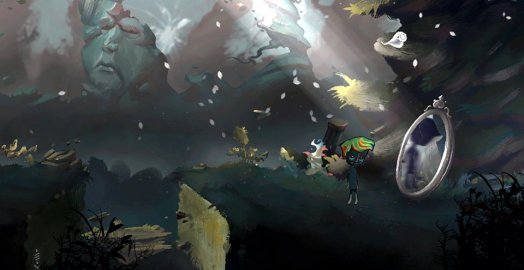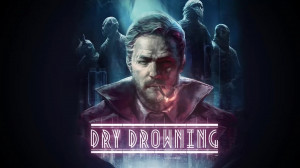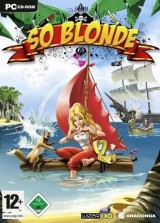Review for Nubla

As a reality-bending puzzle-platformer, Gammera Nest’s Nubla promises to transport players directly into the exhibits of Madrid’s Thyssen-Bornemisza museum, exploring the masterpieces of Cornell, Friedrich, Ernst, and more by submerging players into the artworks themselves. More than just a digital tour of famous paintings, the game wants to instill in players a deeper understanding of these works by interacting with their artefacts through a playfully intimate series of challenges. That’s the pitch, at least.
Being an art nerd, Nubla’s appeal was immediate to me. Even if it was ultimately just a gimmick, it would at least be a pretty, diverting gimmick, right? Turns out, no. Nubla is an unexciting and unexceptional romp through a collection of scrapbooks, their components cut and pasted around the screen in ugly and unamusing ways. It’s not educational or insightful as an interactive gallery, nor is it fun as a game.
The premise is that Illu and Ailla are two students visiting the Thyssen-Bornemisza. During their tour, the gallery goes dark and a group of children appear, all of whom sport strange painted hair and attire. They claim that the light has been stolen from their homes within the artworks, which now consist of nothing but empty voids lining the museum walls. Only with Illu and Ailla’s help can the children jump back inside and restore them to their original condition. To do this, they will need to find Nubla, an ancient, all-knowing elephant who lives in this strange world of art. If they can return a series of constellations hidden throughout the paintings to him, Nubla will make them a paper boat and turn the lights back on. Make sense? Good. Moving on.
The narrative is convoluted, to say the least. While figuring out where to go and what to do is always clear, it just isn’t very engaging. My second playthrough highlighted curiosities and small details I missed in the first, though I’d stop short of calling it enlightening. Nubla is a game about atmosphere rather than telling a cohesive story. And if the gameplay were better, that wouldn’t be such a big deal.
This is a 2D side-scroller divided between two areas of play. At the start, players choose to play as either Illu or Ailla, though this decision appears to be wholly aesthetic. The two students can explore the main gallery, but cannot enter the paintings, where the bulk of the gameplay takes place. To actually travel between the gallery and paintings, you must select one of the children able to do so, having them act as your avatar in their alternate worlds.
The game is broken into three chapters, not including the short introduction. Each chapter sees you jumping into one of the museum’s missing paintings and searching the world within. These are all multi-room affairs with a number of artworks on display. Some rooms are literal framed pictures, with your chosen protagonist walking about the scene as though actually part of it. Others are whole landscapes, comprised of moving platforms and portals between different areas.
There is decent variety to the challenges, ranging from combination locks, music puzzles, and item collection. Some areas require light platforming or the shuffling of items to create a path, while elsewhere you activate a puzzle sequence simply by entering them. In the first chapter, you’ll run back and forth in a small gallery, exchanging artefacts between a series of paintings until a key to open the exit door is obtained. Later you’ll be tasked with deciphering a short combination code linked to Cornell’s Blue Soap Bubble, locking you into the puzzle until you complete it. While these combination-style challenges take some concentration, Nubla’s helper, a small white tadpole (yeah, I know), guides you between points of interest throughout the levels, directing you where to go next. Even without his help, though, it would be hard to get lost.
Unfortunately, this variety is limited by the fact that there are only a handful of puzzles in the entire game – like, six. That’s because Nubla is short. Really short. My first playthrough clocked in at just over fifty minutes, and my second around half that. The puzzles stay exactly the same each time, though some replay value can be found in seeking out the game’s hidden items. Bonus artefacts from paintings, like the nine of spades from Balthus’s The Card Game or the letter from Clouet’s The Love Letter, can be collected just for fun or attaining achievements.
While Nubla does involve a handful of jumping trials, platforming is entirely inconsequential, merely adding dime-thick speedbumps to the otherwise plain, flat ‘press right’ navigation. On PC I played with an Xbox One controller. The default jump button is the trigger, which felt odd, though this can be reconfigured in the start-up menu. There is one segment in a puzzle based off of Edward Hopper’s Hotel Room that utilizes both item combination and jumping, though multi-part challenges like this are rare. There are no game-overs for missing a jump, nor any gut-wrenching Sonic-style music if you stay underwater too long. Jumping simply serves to mask how painfully linear and flat the game’s topography is.
Each child can jump, double jump, and drag (certain) objects. Where the game teases a degree of replay potential is that they all have their own unique ability to help overcome particular obstacles. My first time through I chose a green-haired boy who could teleport short distances. This allowed me to circumvent one platforming section, teleporting through a wall to collect an object I needed. On my second run with a different character, I had to run the gauntlet (if you could call it that) in order to reach it, but this child could levitate, bypassing some of the trickier (again, if you can call them that) jumping segments. These powers, however, are extremely limited in their use. Other than one or maybe two instances, you’ll never find these gifts particularly practical or empowering.
While the gameplay is serviceable, if not very hard, the artwork is the main draw here. Reportedly designed inside the museum itself, with both settings and storyline based on its collected works, the game’s geometry is oblique, with playful constructions paralleling something out of a children’s book. Door and window frames sit at slanted angles, gently warping the scale and dimension of the landscape, and parallax layers fittingly frame the action with an outside-looking-in perspective.
The first chapter’s gallery looks like an alternate reality version of the Thyssen-Bornemisza. The dark hallways are enchanting, turning the museum into a sort of playground with moving platforms and living (albeit static) works of art. The second and third chapters take place in a forest and city, respectively. The former sports lush and mysterious fantasy fare, with tree trunks twisting into humanoid faces, while the latter resembles something of a spooky Chefchaouen, with tones of blue creating a vast network of buildings and cliffs. While pretty, the later landscape backdrops aren’t as interesting as the first, not due to artistic merit but rather to their more simplistic architecture. Whereas the museum feels expansive and mysterious thanks to its labyrinthine level design, the woods and city feel like little more than decorative backdrops to short and linear sprints to the end.
Some of the puzzle challenges take place in rooms based on artworks from the collection, or at the very least utilize props from artworks, but none of them really provide meaningful insight to the works themselves. Hopper’s Hotel Room, for example, is reconstructed from a different angle. Aside from using a few objects from the original, Nubla doesn’t bother to explore the painting’s setting, feeling, technique, or composition in any way (the woman is cut out entirely, further negating the gravity of the scene). It’s a wonder why they chose to include it, or any of the artworks for that matter, other than for variety’s sake.
What’s more, the focus is so zoomed-in, you hardly get to appreciate the broader setting, nor interpret the finer details. What’s worse, I became stuck at one point while running across the second chapter, unable to progress past a phantom barrier. After a few minutes, I realized a cloud that looked like part of the backdrop was in fact blocking my way, and I needed to just hop over it to continue.
Herein lies Nubla’s major visual dilemma: it’s never really clear what you can and can’t touch, or what’s in the background and foreground. Part of the game’s intent is to make players stop and closely examine their surroundings, but I spent more time trying to discern what I was actually able to stand on or interact with than taking in the aesthetic as a whole. More often than not, I found my focus on the paintings broken by distractions like this rather than feeling immersed in them.
The musical accompaniment is made up of relaxing – for lack of a better term – “museum gallery” fare. Soft melodies motivate thoughtful reflection, though they also tend to make the whole adventure blend together. The different paintings all evoke different feelings, and while the change in score from scene to scene does reflect this, that’s still not to say it’s overly memorable. Sound effects are near-absent, with certain puzzle sequences the only place audio comes into play. On one hand, this adds a dream-like aura to the experience, but on the other it makes Nubla feel lifeless.
The real Thyssen-Bornemisza has an impressive collection. If you can’t visit Spain to see it firsthand, I’d recommended browsing through the interactive gallery on the museum’s website. I went there to compare some of the art used in Nubla to the originals, and I can honestly say I had learned far more and had more fun clicking through the gallery than I did playing the game – probably logged more playtime, too.
Nubla mixes frivolous platforming with a series of serviceable if simple puzzles. It’s also extremely short, because the gameplay fails to cater to the different children’s powers, instead forcing repeat runs through the same series of linear puzzles if you can be bothered to at all. As it stands, it’s hard to justify going through the game more than a couple of times just to see the one or two instances where a character’s power comes into play. And that’s a shame, because Nubla had potential. I love the concept, and it’s easy to see Gammera Nest’s love for both gaming and the artworks curated. But with the basic, limited puzzles, drab jumping sequences, and ugly cutups of famous paintings, this is a hard title to recommend to either gamers or even the most devoted art lovers.
WHERE CAN I DOWNLOAD The World of Nubla
The World of Nubla is available at:
We get a small commission from any game you buy through these links (except Steam).Our Verdict:
A great premise tarnished by underdeveloped ideas, Nubla’s puzzle-platforming tour of the Thyssen-Bornemisza museum neither educates nor entertains.




























